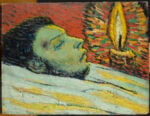Francesco De Prezzo – Al limite del Visibile
.jpg)
Al limite del Visibile sono i quadri di Francesco De Prezzo, dipinti con cura e poi cancellati, o ricoperti da veli che paiono quasi trasparenti.
Comunicato stampa
At the Limits of Visibility are Francesco De Prezzo’s painted canvases, painted with care and then either obliterated or covered with nearly transparent veils. Some of his subjects are entirely abstract, because the final layer of paint is dense and opaque. Others are fully spelled out in their details, having escaped the final brushstroke. In both cases, De Prezzo (Lecce, 1994) has studied the subjects with an eagle eye, spending countless hours portraying the objects that surround him in his studio.
Fabrics, tripods, panels, containers, tiles, hangers and other objects that are used to cover, support, contain or divide and that cast off their simplicity to enter a new dimension and acquire a new aura. What we find in these works is an idea of synthesis and transformation away from figurative painting through a process of layering and covering at the limit of the monochrome, questioning the possibility of fixed visual perception and challenging the role of the image as language.
In Rosalind Krauss’s The Optical Unconscious – a rereading of modernism in which the critic questions some of the idealist dogmas of traditional art history – one of the main themes is that of figure/ground in relation to issues that fuel debate on the concept of “representation”. In De Prezzo’s work, figure and ground switch places, the one going past the other: the image is supplanted and positions itself on a different level. It is the same for his installations, where multiple subject/objects physically enter a shadowy zone, modifying their utilitarian identity to become something else.
No figure, then, either; but a limit case of self-imbrication. The perceptual terms are rejected thus, and marked by this rejection as not-figure and not-ground. But in being canceled they are also preserved. And the logic of that preservation is made transparent by the graph. The graph’s circumference holds all its terms in mutual opposition: figure versus ground; ground versus not-ground; not-ground versus not-figure; not-figure versus figure. Its diagonal axes yield, however, to mirror relations, or rather to mirror restatements (the structuralists’ inverse-of-the-opposite, their double negatives), with figure in this case being the “same” as not-ground.
Rosalind Krauss, The Optical Unconscious, 1993
FRANCESCO DE PREZZO | AL LIMITE DEL VISIBILE
Al limite del Visibile sono i quadri di Francesco De Prezzo, dipinti con cura e poi cancellati, o ricoperti da veli che paiono quasi trasparenti. Alcuni soggetti sono totalmente astratti, perché denso e coprente è lo strato ultimo della sua pittura. Altri sono totalmente esplicitati nei loro dettagli e si riescono a percepire in tutta la sua forma, avendo schivato la pennellata finale. In entrambi i casi la realtà è studiata con precisione da De Prezzo (Lecce, 1994), che trascorre il tempo a ritrarre gli oggetti che lo circondano nello studio.
Drappi, treppiedi, pannelli, contenitori, piastrelle o appendiabiti e altri elementi che servono a coprire, sorreggere, contenere, dividere e che perdono semplicità per raggiungere una nuova dimensione e una nuova aura. C'è un'idea di sintesi e trasformazione dalla pittura figurativa attraverso un processo di stratificazione e copertura che arriva al limite del monocromo, interrogando la possibilità di una percezione visiva definita e discutendo il ruolo dell'immagine come linguaggio.
All’interno del saggio "L'inconscio ottico" Rosalind Krauss rilegge il modernismo mettendo in discussione alcuni dogmi idealisti della storia dell'arte tradizionale e tra gli argomenti principali emergono quello della figura e dello sfondo relativi a problematiche che alimentano dibattiti sul concetto di "rappresentazione". Figura e sfondo, nel lavoro di Francesco De Prezzo, si invertono di posizione, l'uno passa davanti all'altro: l'immagine è scavalcata e si pone su un secondo livello. Lo stesso avviene negli interventi installativi in cui più s/oggetti entrano fisicamente in una ristretta zona d'ombra, modificando la loro posizione funzionale per diventare altro.
Niente figura dunque, ma un caso limite di autoimbricazione. I termini della percezione sono così designati da questo rifiuto come non-figura e non-sfondo. Ma, in quanto cancellati, sono anche preservati. E la logica di questa preservazione è resa trasparente dallo schema. Il perimetro dello schema mantiene tutti i suoi termini in un'opposizione reciproca: figura contro sfondo; sfondo contro non-sfondo; non-sfondo contro non-figura; non-figura contro figura. I suoi assi diagonali producono tuttavia rapporti speculari, o meglio riaffermazioni speculari (l'inverso dell'opposizione degli strutturalisti, i loro doppi negativi), per cui figura in questo caso diventa "identico" a non-sfondo.
Rosalind Krauss, L'inconscio ottico, 1993



